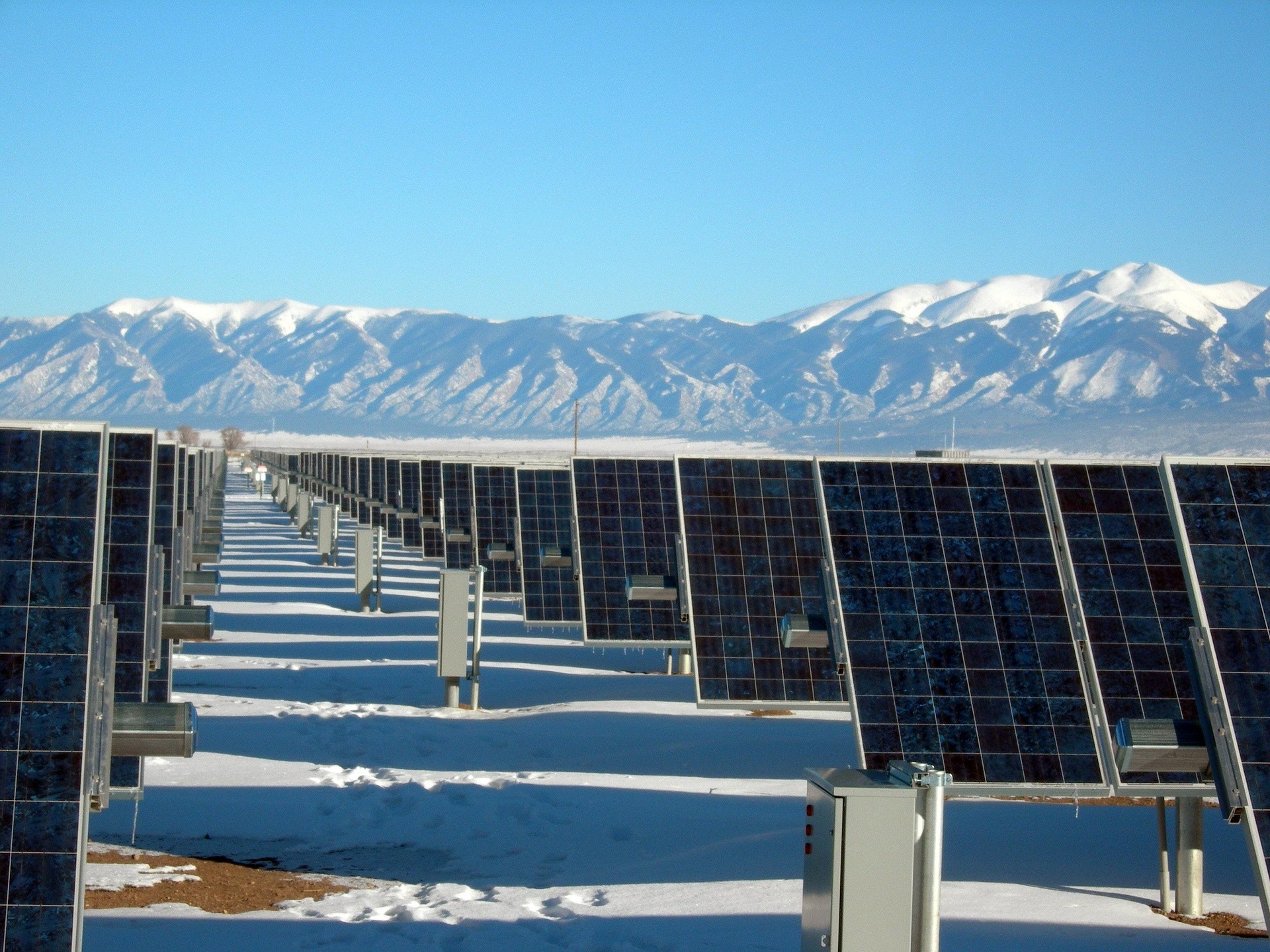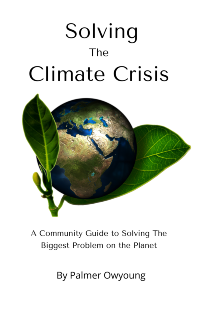We know we need to replace fossil fuels with renewable energy. But as of 2023, we still get about 78 % of our energy from fossil fuels, with coal making up the single biggest source of electricity at 36%. So how do we get from where are today to 100% renewable energy before 2050? Is there a climate change solution? How much will it cost and who will pay for it?
A Climate Change Solution
To answer the first question, we look to Mark Jacobson, a professor of civil and environmental engineering and director of the Atmosphere/Energy Program at Stanford University. In his 2023 Book No Miracle Needed, he puts together a comprehensive plan based on real world data that shows how the world can transition off fossil fuels using existing technology in the form of wind, solar, geothermal, hydo-electric, and battery storage.
According to Jacobson we already have 95% of what we need to get there and the remaining 5% will come from hydrogen fuel cells that can power airplanes and long-distance cargo ships.
The data for his book comes from a detailed blueprint that he published in 2015 of what each of the 50 U.S. States needs to transition their electrical grid, transportation, heating/cooling, and industrial sectors to renewable energy powered by wind, water and sun.
The plan’s goal is to replace 80-85% of fossil fuels by 2030 and 100% by 2050. This time frame is considerably more aggressive than the Paris Climate Agreement and Jacobson not only addresses the need to reduce greenhouse gas emissions and air pollution but does so while keeping energy costs low, creating new jobs, and maintaining a stable power grid.
The Intermittency Problem
One of the biggest issues with solar and wind is the intermittency problem, which means that the sun does not always shine and the wind doesn’t always blow. Jacobson’s 2015 report was criticized for making assumptions about how energy could be stored and it was dismissed as using unrealistic assumptions.
His response was to write the 2018 study that divided the world into 143 countries and 20 regions around the world. Using data and a simulator he and his team looked at the grid stability in each of the regions for every 30 seconds for the past five years to determine the cost of energy per unit.
What they found was that wind, water, and solar power are enough to keep the grid stable and uninterrupted contrary to what his critics said. In fact, he found that there is enough wind generated on the Earth to power our needs 6 or 7 times over and while it’s true this energy is intermittent, he says it would require no more than 4 hours of battery storage in order to solve the problem.
Furthermore, a 2023 study published in Nature indicates that electric vehicle batteries alone could provide the short-term storage needed by global grids as early as 2030.
In countries that have large amounts of hydro-power from dams solving the intermittency problem is relatively easy. In other countries, Jacobson says the problem can be solved with better energy storage, by better managing demand, and increasing the capacity of renewables by connecting them over wider areas.
Also, storage does not have to come in the form of lithium-ion batteries, which can be expensive. Other alternatives include pumped hydro, storing heat in boreholes, and gravity batteries that involve raising and lowering weights, all of which are magnitudes cheaper than lithium-ion batteries.
The Energy Mix
So, what would Jacobson’s plan look like put into action? If you wanted to power the entire world with wind, water, and solar one way to do it would be by allocating 50 percent to wind 40 percent to solar and 10 percent to hydoelectric. This would translate to roughly 4 million 5 megawatt wind turbines; 90,000 300-MW solar photovoltaics, some concentrated solar power plants, and 1.9 billion 3 KW solar panel rooftop systems. The remaining 10 percent would be comprised of geothermal, and hydro-electric, tidal turbines and wave energy.
Building the infrastructure for all of this and maintaining it is expected to create at least 52 million jobs worldwide, although about 24 million jobs would be lost during the transition away from fossil fuels, leaving a total of about 28 million new jobs created.
For the U.S. the breakdown would be 42% solar, 47% wind and the rest made up of geothermal and hydroelectric. This would require the construction of 288,000 large wind turbines and 16,000 large solar farms and would create 3.1 million new jobs.
Cost Savings
Since the price of wind and solar energy are cheaper and more stable than fossil fuels. Jacobson says that the average electric bill would fall 63%. A report published in 2020 by Rewiring America, an energy policy non-profit supports this and says that transitioning to 100% renewables would save the U.S. $321 billion in energy costs alone, or about $2500 per household per year.
One of the reasons for the savings is because of the increase in efficiency that you get when converting from fossil fuels to electricity. For example, according to the U.S. Department of Energy electric motors are about 77% efficient while internal combustion engines are only 12% to 30% efficient. In other words, the electric motor converts the majority of the electricity it receives into driving the vehicle, while a fossil fuel burning engine converts most of its energy into heat that is wasted.
Cheaper energy could have a lot of positive economic and social implications leading to lower transportation costs, less expensive goods and services and lower food costs as well.
Jacobson says that the barrier to transitioning from fossil fuels to renewable energy isn’t technical or economic but rather political. Some of this comes from oil companies dragging their feet and the $26 trillion dollars worth of fossil fuels that are still buried in the Earth.
Reduction of Air Pollution Deaths
Jacobson’s study found that the cost of renewable energy would also be about 75% cheaper than fossil fuels by 2050 because of the savings on health costs associated with air pollution. The World Health Organization (WHO) estimates that 7 million people die annually from it, at a cost of $2.9 trillion in 2018 (or $8 billion per day).
According to the Center for Research on Energy and Clean Air. Switching to renewable energy not only means reducing the damage from climate change, but it will also save lives and money. Jacobson’s team estimates that as many as 5.3 million lives will be saved each year from the improvement of air quality alone. When health and climate costs are factored in, the average household in the world would save almost $6,000 per year.
Cost
So how much would it cost to put this plan into motion? In 2022 Jacobson updated his study for a third time and according to his team’s analysis, it would cost approximately $62 trillion to implement. However, this would be spent over a few decades between 2022 and 2050, so the annual cost would break down to about $2.21 trillion per year, which equates to about 2.5% of global GDP. A small price to pay to avert catastrophe.
Jacobson and his colleagues say that remaining on fossil fuels could cost four times as much due to increasing health costs and damage to infrastructure. One study put the cost from just the Arctic heating up at $67 trillion by the end of the century.
Also, Jacobson’s plan could end up paying for itself through energy savings, and lower healthcare costs. They estimate that it could take as little as 6 years for the transition to pay for itself when factoring in savings from preventing climate change losses, increases in efficiency, decreases in the price of electricity, and savings in healthcare costs.
Land Needed
One of the biggest complaints about wind and solar is that they take up a lot of space. However, Jacobson points out that the actual footprint for wind turbines is not that large and the land next to it can be used for other things like farming. Wind turbines can also be built offshore on platforms.
Next Generation Wind Turbines
There are also next-generation vertical and bladeless wind turbines, like Aeromine, that have just come on the market. They have a footprint that is 10 foot by 10 foot (3 by 3 meters) is almost silent, requires little maintenance, and works even when there is very little wind available.
The Aeromine also takes up about 10% of the space of solar panels, while providing 50% more energy. Furthermore, it does not kill bats and birds, is quieter, and is less of an eyesore than conventional wind turbines.
Solar Panels
While it is true that solar farms can take up a lot of space, there has been recent interest in placing them in canals and other bodies of water. This not only prevents evaporation but also reduces potentially toxic algae blooms in lakes.
A second solution is to put solar farms on the rooftops and parking lots of abandoned shopping malls. This way no new land is required.
A third solution is putting solar panels above crops, this is called agrivoltaics and has a lot of benefits such as protecting the plants against extreme heat, reducing water usage, improving soil quality, and increasing the output of the solar panels.
There is also the arrival of next-generation solar technology like solar films from companies like Heliatek and Ubiquitous Energy that can turn our buildings into solar farms. This technology is available today, but needs scaling up.
In total Jacobson’s plan estimates that all new wind, water and solar generation would require just .53% of the Earth’s total land to make it a reality.
Why We Don’t Need Nuclear
A few ways that his plan differs from others is that it excludes nuclear, He says that in the U.S. a new nuclear plant costs 4 to 6 times that of solar or wind to produce the same amount of electricity. A nuclear plant also takes 5 to 17 years longer to design, plan and build than a solar and wind farm.
Given that some climate change plans call for a transition to 100% renewable energy by 2035 it does not leave much time for but a handful of nuclear plants to be built. In addition, the air pollution from those added years would lead to millions more deaths and add unneeded medical costs.
In terms of emissions nuclear emits 9 to 37 times the carbon over its life as onshore wind. This comes from the fossil fuels used during the mining and refining of the uranium, the concrete to build the nuclear plant, and the excess fossil fuels burned while it is being built.
Critics
Of course, there are critics of Jacobson’s plan. One is that mining the metals, necessary to build the renewables will be both destructive and expensive. However, Jacobson responds that “The total amount of mining that’s going to be needed for wind, water, solar, compared to the fossil fuel system, is much less than 1% in terms of the mass of materials.”
Alternative Mining Methods
There are also alternative, less destructive methods of mining that are being developed. For example, researchers around the world are experimenting with biomining, using microbes to leach rare earth elements from ores or recycled e-waste. Although it is still in the experimental phases it could become a reality in the next decade.
In the meantime, phyto-mining, using plants to absorb and store minerals and metals from the soil is already being done on a small scale in Malaysia and France. This method is used mostly for nickel, but 700 species of plants have been found that can absorb thallium, zinc, copper, cobalt, and manganese.
Jacobson Is Not Alone
If Jacobson and his team were alone in their assertions that renewables can power the world, it might be easy to pass them off as a group of wishful thinkers, but they are not alone.
A 2021 study published in Nature says that solar panels on just half of the world’s rooftops would provide enough energy to power the world.
Similarly a 2021 report titled The Sky’s The Limit, produced by the UK think tank Carbon Tracker, concluded that solar and wind energy can meet global electricity demand 100 times over, and the cost of renewable energy is dropping so quickly that they can completely replace fossil fuels by 2035.
According to the report, the world demand for energy in 2019 was 65 petawatt hours (PWh). With current technology, we could produce about 5800 PWh of electricity per year with solar alone. Onshore and offshore wind could capture another 900 PWh.
Furthermore, the land required for just solar panels to provide global energy is about .3% of the earth’s total land mass, which is less than what fossil fuels currently use.
How Do We Pay For It?
So the big question is how do we pay for all that clean energy? Yes, Jacobson and his team say that it would pay for itself in 6 years in saved electricity and healthcare costs, but that still leaves the startup costs. After all, $2.21 trillion isn’t just going to fall from the sky.
However, an analysis by Oxfam called Taxing Extreme Wealth gives us a clue where the money could come from. A wealth tax starting at just 2 percent annually for those who have over $5 million rising to 3 percent for those who have more than $50 million and 5 percent annually for billionaires would generate $2.52 trillion a year.
This would be enough to pay for all of Jacobson’s plan to completely transition the world from fossil fuels to renewable energy and leave $300 billion left over for pizza, beer, and cake to celebrate.
A steeper progressive tax of 2%, 5% and 10% would raise $3.62 trillion a year, meaning we could also address extreme poverty, education, and healthcare.
The Wealthy Wouldn’t Go for It?
I can hear the cynics out there grumbling that the wealthy would never go for a wealth tax. But believe it or not, it was a group of millionaires called the Patriotic Millionaires that paid for the Oxfam study because they are a small but growing movement of wealthy people who are asking to be taxed more.
It has even led to the formation of several global organizations centered around the idea. I mentioned the Patriotic Millionaires, there’s also Millionaires for Humanity, and Tax Me Now. All these organizations are run by millionaires and billionaires asking for the government of their respective countries to tax them more.
In 2022, one hundred millionaires and billionaires went so far as to sign an open letter asking to be taxed more and presented it to the World Economic Forum in Davos. So, the question is what are we waiting for?
You can find out more about the Jacobson plan and see what it would look like in your country by going to the TheSolutionProject.org or reading his book No Miracles Needed.



